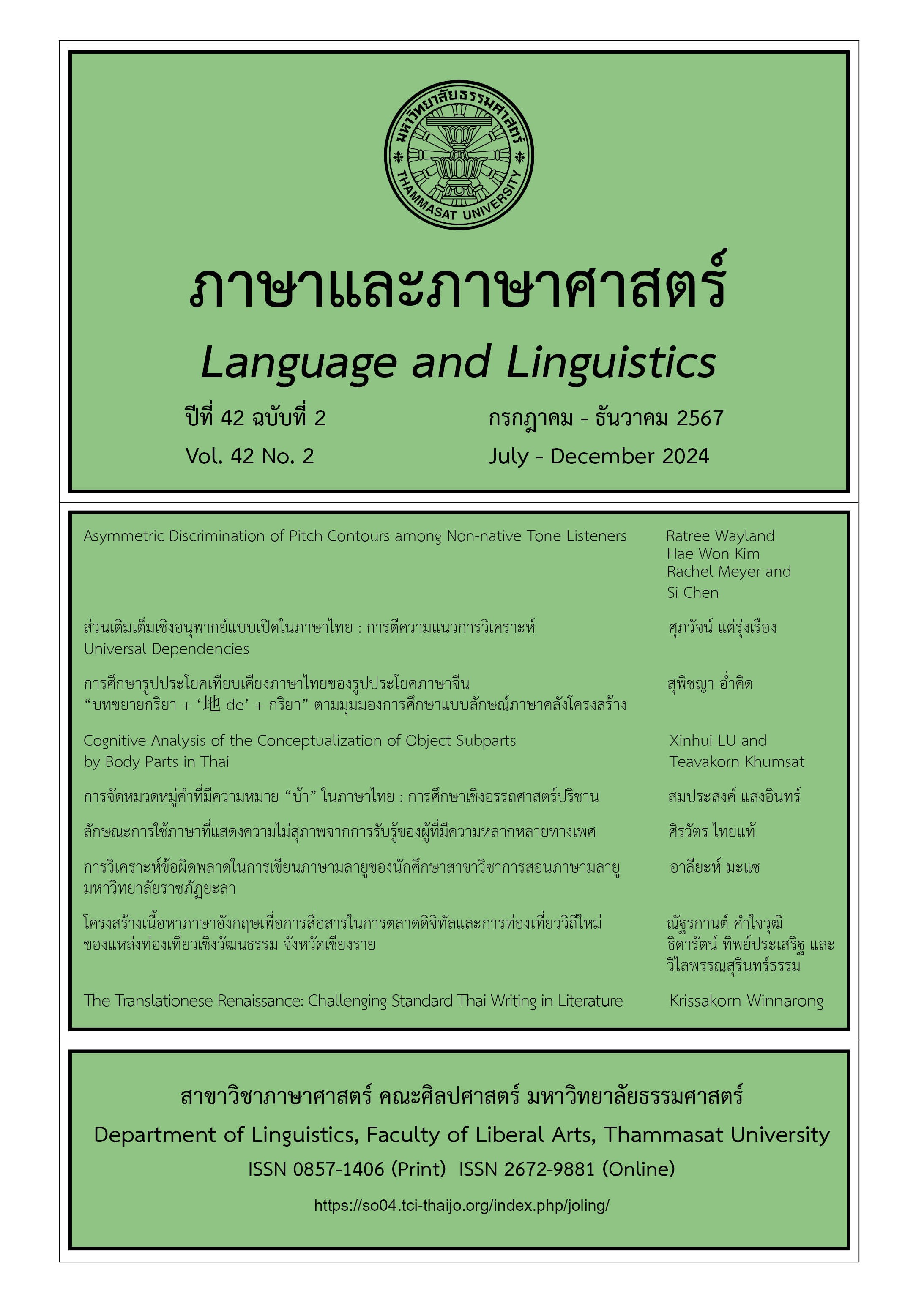Analysis of Errors in Malay Writing among Malay Language Teaching Students at Yala Rajabhat University
Main Article Content
Abstract
Analyzing language errors is crucial for improving communication and reducing the risk of confusion or misunderstanding. It also aids in the development of grammatically structured language. This study aimed to examine errors in Malay language writing among second-year students at Yala Rajabhat University. Data were collected from 32 participants (29 females, 3 males) who completed an essay and midterm writing exam for the Malay Grammar for Teachers course. The assignments were selected and analyzed using purposive sampling. The error data were categorized into three areas: orthography, word use, and sentence use. The findings indicate three types of orthographic errors: 1) spelling mistakes, 2) misspelling of borrowed words, and 3) errors in the use of uppercase and lowercase letters. In terms of word use errors, there were four types: 1) incorrect word use, 2) errors in conjunctions, 3) errors in prepositions, and 4) errors in the use of prefixes and suffixes. Regarding sentence use, there were three types of errors: 1) errors in constructing sentences, 2) errors in using phrases, and 3) errors in forming passive sentences. The research results can inform the development of teaching and learning strategies to improve Malay language writing among students in the future.
Article Details

This work is licensed under a Creative Commons Attribution-NonCommercial-NoDerivatives 4.0 International License.
บทความทุกบทความเป็นลิขสิทธิ์ของภาษาและภาษาศาสตร์
References
จินตนา พุทธเมตะ และ สุวศิน เกษมปิติ. (2562). การวิเคราะห์ข้อบกพร่องการเขียนภาษาไทยของนักศึกษากลุ่ม Gen Y. วารสารมนุษยศาสตร์และสังคมศาสตร์ มหาวิทยาลัยนครพนม, 9(3), 79-87.
ดวงใจ ไทยอุบุญ. (2550). ทักษะการเขียนภาษาไทย (พิมพ์ครั้งที่ 4). สำนักพิมพ์แห่งจุฬาลงกรณ์มหาวิทยาลัย.
พระมหานรินทร์ ประสมพงศ์ และ พระมหาสมศักดิ์ ทองบ่อ. (2566). การเขียนเพื่อการสื่อสารในชีวิตประจำวัน. วารสาร “ศึกษาศาสตร์ มมร” คณะศึกษาศาสตร์ มหาวิทยาลัยมหามกุฏราชวิทยาลัย, 11(1), 39-51.
สุมาลี นิมมานุภาพ. (2544). บาฮาซามาเลเซียพื้นฐาน 1 (พิมพ์ครั้งที่ 3). สำนักพิมพ์มหาวิทยาลัยรามคำแหง
สุวิไล เปรมศรีรัตน์, นักวิจัย. (2556). การจัดการเรียนการสอนโดยใช้ภาษาท้องถิ่นและภาษาไทยเป็นสื่อ: กรณีการจัดการศึกษาแบบทวิภาษา (ภาษาไทย-มลายูถิ่น) ในโรงเรียนเขตพื้นที่สี่จังหวัดชายแดนภาคใต้ ระยะที่ 2. รายงานการวิจัยฉบับสมบูรณ์. สำนักงานคณะกรรมการการส่งเสริมวิทยาศาสตร์ วิจัยและนวัตกรรม.
ราชบัณฑิตยสถาน. (2556). พจนานุกรมฉบับราชบัณฑิตยสถาน พ.ศ. 2554 : เฉลิมพระเกียรติพระบาทสมเด็จพระเจ้าอยู่หัว เนื่องในโอกาสพระราชพิธีมหามงคลเฉลิมพระชนมพรรษา 7 รอบ 5 ธันวาคม 2554. นานมีบุ๊คส์พับลิเคชั่นส์.
วันชัย แก้วหนูนวล และ ภัสร์ธีรา ฉลองเดช. (2561). ลักษณะข้อผิดพลาดในการใช้ภาษาไทย: กรณีศึกษาการเขียนภาษาไทยของนักศึกษาปริญญาตรีชั้นปีที่ 1 มหาวิทยาลัยนราธิวาสราชนครินทร์. วารสารมหาวิทยาลัยนราธิวาสราชนครินทร์ สาขามนุษยศาสตร์และสังคมศาสตร์, 5(2), 1-11.
อาลียะห์ มะแซ, ซามียะห์ บาเละ, และ ไซนีย์ ตำภู. (2564). การพัฒนาบทเรียนภาษามลายูสำหรับนักเดินทางในบทเรียนออนไลน์ระบบเปิด Thai-MOOC วิชาภาษามลายูเพื่อการสื่อสาร มหาวิทยาลัยราชภัฏยะลา. วารสารมหาวิทยาลัยราชภัฏยะลา, 16(2), 258-266.
Abd Hamid, M. F., Mokhtar, D. S., & Haron, R. (2022). Analisis Kesalahan Tatabahasa dalam Teks Perutusan Khas Perintah Kawalan Pergerakan (PKP) untuk Mengawal Wabak COVID19. PENDETA, 13(1), 84-102.
Corder, S. P. (1981). Error analysis and interlanguage. Oxford University Press.
Dalle, A., Amir, J. & Asri, W. K. (2022). Improving students writing skill using serial images as learning media. Asian EFL Journal, 27(3.3), 28-36.
Dulay, H., Burt, M., & Krashern, S. (1982). Language two. Oxford University Press.
Fadhly, F.Z., & Ratnaningsih, N. (2018). Reconstruction of cognitive process in popular article writing. The Asian EFL Journal, 20(5), 7-33.
Karim, N. S., Onn, F. M., Musa, H. M. & Mahmood, A. H. (2015). Tatabahasa Dewan (edisi ketiga). Dewan Bahasa dan Pustaka.
Klassen, C. (1991). Bilingual written language use by low-education Latin American new comers. In D. Barton and R. Irani (Eds.), Writing in the community (pp. 38-57). Sage Publication.
Li, C. & Ruan, Z. (2020). Language difficulties of EAP learners at English-medium contexts: a case study of Chinese tertiary students at XJTLU in Mainland China. Asian EFL Journal, 24(3), 32-50.
Mantasiah, R., Yusri, Y., & Jufri, J. (2019). The role of bilingualism in increasing children’s cognitive ability at primary school. Asian EFL Journal, 23(6.2), 27-41.
Norrish, J. (1983). Language learners and their errors. Macmillan Press.
Nurul, A. A. & Nik Mohd Arif, N. N. A. (2021). Error analysis in international students’ Malay language written compositions.
International Social Science and Humanities Journal, 4(1), 113-127.
Richards, J.C. (1974). Error analysis: Perspectives on second language acquisition. Longman Group.
Solfiyatuzzahro, S., Santihastuti, A., & Erfan, E. (2019). Grammatical accuracy using teacher’s written corrective feedback. Eralingua: Jurnal Pendidikan Bahasa Asing dan Sastra, 3(2), 75-85.Nik


